Table of Contents
Table of Contents
EXECUTIVE SUMMARY
Current academic interest in social capital is robust and extensive, ranging across dozens of disciplines from economics to geography to medicine. 1 1 This whitepaper constitutes chapter 3 of Milton J. Friesen, “Social Imaging: Social Capital and Spatial Use Patterns with Potential Correlations” (PhD diss., School of Planning, University of Waterloo). The Web of Science Core Collection (WoS) contains fifty-seven million academic papers, books, conference proceedings, and citations across the social and natural sciences. Within that repository, social capital is well-represented, with more than 9,164 records as searched on November 1, 2014. Navigating this body of research will support scholars, policy-makers, and community leaders who blend research and practice to understand more clearly what social capital is and how it works. The approach is not exhaustive but is substantially illustrative of how widely the social capital concept is invoked. A current review of the Web of Science sources reflects more than 14,000 sources from the repository of 100 million items. Interest in social capital is significant and growing.
It is clear that the civic landscape is highly complex. Social capital across dozens of disciplines, scholars, countries, institutions, and timescales reflects this complexity. While the intricate nature of these phenomena may be daunting, pursuit of insight can yield important gains and provide a degree of humility in our various pursuits.
This whitepaper provides a large-data-set overview of the extensive landscape of published academic work on social capital. The growing body of research on this topic is complex and of interest to many disciplines, and in what follows I will thematically review the breadth of that research.
A demonstration of the finer-grained approaches within this wide literature is undertaken by examining four important categories of social capital: trust, measurement, spatial dynamics, and social isolation. The paper concludes with five observations about social capital scholarship: (1) sociology and business/economics are core social capital disciplines; (2) the most prolific social capital authors work primarily in health sciences; (3) the United States is a central player in social capital research; (4) academic articles rather than books are the dominant forum for exchange with methodological studies being an important sub-class; and (5) academic publishing in social capital has grown significantly in the last ten years despite uneven adoption at policy levels.
NAVIGATING SOCIAL CAPITAL SCHOLARSHIP
A META-REVIEW OF 9,164 WEB OF SCIENCE SOURCES ON SOCIAL CAPITAL
REAS OF CONSIDERABLE SCHOLARLY activity that involve dozens of disciplines require more than cursory or narrowly focused reviews of select literature. When thousands of sources are involved, they form a primary data source in their own right, including the possibility of analyzing authorship, citations, abstract content, dates, countries, and institutional patterns. Social capital remains an exploratory social theme with no single disciplinary home. Exploratory work within and between these multiple disciplines is critical to ongoing fruitful inquiry. Textual, citation, and thematic analysis presented here can provide supporting orientation for practical and theoretical research development.
EARLY YEARS OF SOCIAL CAPITAL SCHOLARSHIP
Prior to 1993, it is possible to trace a paper-to-paper linkage of key works on social capital and to consider their various themes and ideas. This identified range (table 1) (Ostrom and Ahn 2003) represents a 153-year span of time from the early use of social capital found in Democracy in America (Tocqueville 2001) through to Making Democracy Work (Putnam, Leonardi, and Nanetti 1994). The following is not a comprehensive review of all uses or related uses of social capital but is instead a review of significant growth in social capital interest. Durkheim is an example of a late nineteenth-century use of social capital in a discussion of the conditions of suicide (Chen et al. 2009). In the second half of the twentieth century there was an increase in the number of academic works on social capital, but it was a pivotal paper on human and social capital in the late 1980s helped to accelerate scholarly interest (Coleman 1988). (See TABLE 1.)
PRIOR TO 1993, it is possible to trace a paper-to-paper linkage of key works on social capital and to consider their various themes and ideas
A few observations about this traced path- way will provide illumination of the point. L. J. Hanifan (1916) published a paper just after World War I describing how a local school could function as a community centre and in so doing contribute to the overall social resources, the “social capital” of the community in which it resided. The idea that a common pool resource in the form of a collective social good could be generated through the functions of a community institution was not new, but describing it as a form of capital, as social capital, was distinctive. However, prior to 1993, scholars simply did not cite Hanifan, but now the paper is a clear example of a “sleeping beauty” that suddenly wakes up (Ke et al. 2015; Raan 2004). By 2000 there were two citations, but just five years later, the citation curve had increased to 22.
By 2010 the number of records that cite Hanifan was 57, nearly three times the number in 2000. And by 2014 there were 103 records citing Hanifan (FIGURE 1).
This brief case study of an obscure scholarly paper being picked up by contemporary researchers is indicative of growing scholarly interest in social capital research. There are other facets to be considered in this early period, including the work of urbanists and planners. Jane Jacobs has been identified as a key social capital contributor despite being better known for her work in urbanism (Ostrom and Ahn 2003). Jacobs was not a social capital scholar but was instead an observer of the effects of collective action (or lack thereof) in urban settings and remains one of the most-read sources for planners and urbanists (Filion, Shipley, and Zeralynne 2007) along with economists and political scientists (Sancton 2000). She is, however, scarcely represented in the WoS database. The Life and Death of Great American Cities is not listed, and since Jacobs was not a formal scholar who published in the academic literature, her footprint in the space is minimal. Despite this, she has had an extraordinarily wide influence in planning and urban development, including the social capital facets of city building and design in her work. However, when “Jacobs, Jane” is searched for as a subject, the results show a stronger signal, with 106 records returned. The earliest record in this list is a J. Mixon article that examines how Jacobs’s ideas would look from a zoning vantage point (Mixon 1967), but Mixon does not pick up the social capital theme, which is a reminder of that not all contributions to social capital scholarship are included in something like a phrase search even where the number of returns is significant.
THE IDEA THAT A COMMON POOL RESOURCE in the form of a collective social good could be generated through the functions of a community institution was not new, but describing it as a form of capital, as social capital, was distinctive.
Theodore Schultz’s work on human capital in 1961 was published as an academic article in a prominent journal (American Economic Review). Given that prominence, along with the “Matthew Effect” (the rich get richer, the cited get more cited), which occurs with prominence and time, it has a significant number of citation records (864) (FIGURE 2).
Glenn Loury’s contribution to social capital (1977) appeared as a chapter in a book, not as an academic journal article, so it does not appear in the WoS citation records and represents an obscure (or sleeping) source that is more contemporary than Hanifan.
Google Ngram (Lin et al. 2012) searches of broad published data show a comparable level of word use activity for “social capital” as a word pair (FIGURE 3). Google Ngram data can be downloaded as well for additional analysis with statistical software, but this cursory analysis is sufficient to note general trending of the phrase. The occurrence of “social capital” from 1980 to 1990 represents a fourfold increase, while the increase from 1980 to 2008 is eightfold.
After 1993, however, a surge of interest begins to develop that soon makes individual paper listing impractical (with James Coleman’s 1988 paper as an important trigger). The building volume of scholarly work on and related to social capital forms a vast stream in which identification of themes, subject areas, and categories becomes essential as a strategy for reviewing the literature. Based on the sheer numbers, the top twenty themes in WoS provide new sub-paths that can be examined in their own right to identify the primary avenues of research and writing on social capital.
MATERIALS AND METHODS
FIGURE 4 (found on page 12) is a representative summary of the elements used in this meta-review of the social- capital-scholarship landscape. There are many complex pathways that analysis can take in approaching such a large number of source papers and data elements. Choices for analyses are open at each juncture, and the lower half shows the sub-search categories that are examined in this paper: isolation, measurement, social isolation, spatial dynamics. These four themes are identified as most relevant in order to provide a pathway into more detailed analyses approaches. In some cases, the file formats of the data are noted as are the software tools used to review, analyze, and display the data.
Data analysis may be usefully classified into six types (Leek 2013) that are useful for orienting the meta-review being conducted (TABLE 2). The analysis in this paper will consist primarily of the first three categories—description, exploration, and inference—leading to key conclusions about the current state of global, English-language academic research on social capital.
WEB OF SCIENCE CATEGORIES
The WoS “categories” function as disciplinary divisions and are administered by WoS. Social capital records include 162 out of 256 WoS categories with two or more records (see complete list http://ip-science.thomsonreu- ters.com/mjl/scope/). The top twenty categories cover 68 percent of the total. Within the top twenty categories, there are some that are more relevant than others for various research interests. For example, the Social Imaging Project (http://www.socialimaging.org), which examines the relationship between spatial patterns and social capital, can serve as an example of how the large paper database can subcategorized for further analysis. Using four search terms (trust, measurement, isolation, and spatial) as segmented subsets of social capital, I will examine a variety of themes and trends that improve our understanding of social capital scholarship. These subsets can also be compared with the research areas that WoS uses and can be further refined by paper authors. There is not significant variance between the two, and given that WoS categories are more consistently administered and include two additional areas of relevance, it would seem to be the best choice for analysis (TABLE 3). The primary breakdown for research areas include the following: life sciences and biomedicine; physical sciences; technology; arts and humanities; social sciences. Details about more detailed sub-areas can be found here: http://images.webofknowledge.com/WOKRS57B4/help/WOS/hp_research_areas_easca.html
Another way of comparing “categories” and “research areas” is to examine how a specific group compares, in this case the top twenty-four “categories” and “research areas” within the WoS “social capital” search return (FIGURE 5).
Searching within the original 9,164 “social capital” records, the planning development and political science categories add 1,034 more records to the analysis. “Social science other topics” used in research areas appears to be broader, including 206 more records than the “social sciences interdisciplinary” used in the WoS categories. These represent the variances between the two disciplinary breakdowns. The wider list of WoS categories reflects a significant diminishment in the number of records per discipline (FIGURE 6).
Networks can be analyzed for communities or areas where connections between nodes are higher than others. This “lumpiness” indicates a higher degree of commonality and is often referred to as “modularity” in network science. For example, the modularity of WoS “social capital” citation network reveals four general communities within the single component, directed network represented by the citation connections. Applying Gephi’s modularity analytics shows that there are four distinct groups, with memberships in each group ranging from 30 to 75 (FIGURE 7). Gephi analytics uses fast unfolding networks (Blondel et al. 2008) and modular structures (Lambiotte, Delvenne, and Barahona 2008) analysis to calculate groupings based on citation and category overlaps.
If the citation links of WoS categories represented by the “social capital” search are mapped, areas of more and less significant interaction occur, including significant interconnectivity across disciplines (FIGURE 8). The upper left include sociology, geography, and political science, while the blue/black region includes the physical sciences. The brown region is primarily related to engineering and some environmental sciences. The brighter green is biology related and the red is medical sciences. The size of the circles (nodes) indicates the relative number of records and the connections are the number of citations. Citation data was extracted from WoS, converted to .gexf format using an Excel macro, and then imported into Gephi for visualization and analysis.
With the WoS categories colourized, including the citation links that connect them, the wider patterns noted above reveal important detail when zoomed in further (FIGURE 9) and provide useful context for more specific, focused research depending on
As noted above, the WoS research areas reflect some variance from the WoS categories but in substance appear to follow that pattern in significant ways so that analysis of “categories” provides reliable guidance into social capital disciplinary and thematic research areas.
CITNETEXPLORER
Visualizing the top 500 most cited sources by author with the CitNetExplorer software provides a view of the works cited (links that go up) and works that cite the given source (links that go down). For the purpose of visual clarity and processing speed, the CitNetExplorer limits the visualization to 100 sources, but the analysis is based on 3,778 “social capital” publications from WoS, with 14,126 citation links. Coleman (1988) is highlighted with a square node (FIGURE 10). Given that this is a key social capital paper, we should see greater downward links (scholars citing Coleman) and fewer upward links (Coleman citing predecessors). This is what we do see.
An additional feature of the CitNetExplorer visualization is colouring clusters based on bibliographic coupling—the more they cite sources in common, the more centralized they become (FIGURE 11). In network theory this modularity is reflective of groups or communities within the data (Newman, 2010).
As the number of sources is increased, an interesting node of disconnected scholarship emerges as a grey cluster in the lower left side of the diagram (FIGURE 12).
The relational ties of social capital may be invisible from an observational standpoint, but they are very powerful.
WEB OF SCIENCE CORE COLLECTION ANALYSIS—“SOCIAL CAPITAL”
Within the full collection of more than 57,000,000 records that constitute WoS (2014) more than 9,164 records are returned by a “social capital” search. The relative sizes and key counts for the textual database are summarized in TABLE 4. The following section demonstrates how analyses can be undertaken by themes such as authors, countries, and document types.
Distribution by Authors
A significant number of unique authors constitute the social capital scholarly landscape. Although there is a small handful of unusually prolific authors among the top 20 (FIGURE 13), it is also significant that there are 3,017 individual authors listed who have 2 entries or more but who are outside of the top 20 most prolific author list. This long tail of social capital scholarship viewed from an authorship vantage point is consistent with the significantly cross-connected citation network noted earlier.
Distribution by Countries
The top 20 countries shows the very significant US trend in social capital related publications (FIGURE 14). The top 5 countries constitute 6,244/9,164 entries (68 percent). There are 103 countries that had two or more social capital entries in the literature. The WoS “social capital” search is English-language only and is a limit in terms of a full global analysis of sources.
Distribution by Document Types
Journal articles are by far the most popular format for scholarly engagement on social capital themes (FIGURE 15). If conference proceedings are considered, the two types encompass 8,565/9,164 of the entries (93 percent). The implication is that the field is still relatively new, is of interest across many disciplines, and has not yet reached a mature phase of scholarly inquiry.
Journal articles are by far the most popular format for scholarly engagement on social capital themes.
Distribution by Publication Years
Prior to 1991 the number of publications demarcated by “social capital” was fewer than 2 (FIGURE 16). Steady increase in interest continues to the present with a doubling of records from 1997 to 1998, another doubling by 2002, and again by 2007.
Distribution by Conference Titles
The distribution of conference titles related to social capital themes has a much flatter, longer tail (FIGURE 17). There are 207 individual conference titles listed with two or more records, with the most prolific conference yielding 14 records and many more titles with fewer than 2 entries. This does not appear to be an efficient way of narrowing the social capital field. Given that there is a natural movement from conferences and proceedings to academic papers, it can be reasonably inferred that content from these gatherings finds its way into the articles records list. There may be more recent gatherings where material has not yet been published or where new ideas or themes are emerging. The most recent conferences search could provide leads for further research through direct contact with conference organizers or participating scholars.
Distribution by Institutions
The top 20 universities publishing work on social capital represent just slightly less than 20 percent of the total active institutions— (2,251/11,638). American universities are, as is expected based on earlier country data, significant, though the university with the most major contributions to the field is in England (FIGURE 18). In Can- ada, the University of Toronto is a major contributor along with the University of British Columbia.
In Canada, the University of Toronto is a major contributor along with the University of British Columbia.
ANALYSIS OF ABSTRACTS
The more than 9,000 abstracts in the core data set comprises 1,373,119 words, making manual, sequential analysis impractical. As a data-exploration strategy, the first 1,500 abstracts were broken into three segments of 500 abstracts each to work within the limits of VosViewer. When “social capital” and non-relevant words from the abstracts (e.g., “conclusion,” “Elsevier Ltd”) were removed, the remaining text was analyzed using VosViewer. A heat-map image based on word frequency and proximity to other words provides an view of the thematic context (FIGURE 19). Terms such as “health,” “measure,” “network,” “concept,” and “framework” show greater significance than a wide range of other secondary and tertiary terms.
As noted earlier, a network map is another way to visualize the same data (FIGURE 20). In the interests of space, each 500 abstract subsection of the 9,164 sources was not produced so that these images are representative. This preliminary analysis suggests that these themes and emphases are consistent across the more than 9,000 abstracts.
FOCUS ON FOUR THEMES WITHIN WoS DATA
The significant scope of WoS sources related to social capital requires analysis beyond the previous counting and statistical exploration. The nature and focus of the Social Imaging Research example project makes use of areas identified earlier. For the purposes of this paper, these more specific research areas demonstrate how analysis could be conducted within the larger data set generated by the WoS “social capital” search returns. Other op- tions within the “social capital” database can be detected by text mining the data (FIGURE 21).
TRUST AND SOCIAL CAPITAL
Within the “social capital” search return, 1,842 records were returned from the “trust” search. Analysis of these data provided indications of the academic and thematic contexts where trust and social capital converged. In particular, exploratory analysis of the abstracts from the academic papers revealed a strong emphasis on health, community, knowledge, networks, and participation (FIGURE 22). The abstracts were cleaned, removing various given words (“social capital,” small words, “conclusion,” “objectives,” and so on) and then analyzed using text cleaning and mining procedures in R to generate bar graphs of word frequency organized alphabetically.
The conclusion of this analysis showed that trust is a very significant aspect of social capital research across a wide range of disciplines.
The conclusion of this analysis showed that trust is a very significant aspect of social capital research across a wide range of disciplines. Trust is very well represented in the most cited papers, which, by nature, have earlier publishing dates (FIGURE 23). Health studies that explore early mortality and mental health, for example, reflect significant interest in trust (Kawachi, Kennedy, and Glass 1999; Kawachi et al. 1997), as do organizational management studies aimed at understanding firm performance, knowledge exchange, and innovation (Inkpen and Tsang 2005; Knack and Keefer 1997; Leana and Van Buren 1999; Tsai and Ghoshal 1998). The linkage between trust and geography, adaptation, environmental engagement, online use, and change were clearly represented (Adger 2003; Folke et al. 2005; Pretty and Ward 2001). It was also interesting to note how existing data sets such as the General Social Survey were utilized in top-cited papers to explore the linkage between trust and social capital (Brehm and Rahn 1997; Kawachi et al. 1997). In one recent paper, social capital and trust levels were utilized to explore how their relative and dynamic levels could be used as predictors of conditions that, along with other political and ethnic considerations, pre- dispose an area to genocidal risk (McDoom 2014).
The geographic distribution by country pattern noted in the complete data set was much the same for the trust subset (FIGURE 24). North America and England were significantly represented. Germany and the Netherlands dropped in rank, though, to be replaced by Sweden and China. Further analysis of the American data could be conducted to determine by institution which universities were most active in linking these two terms.
MEASUREMENT AND SOCIAL CAPITAL
The emergence of social capital in the late 1980s as a topic of academic inquiry led to a direct and sustained interest concerning how it might be credibly and consistently measured. The complexity of the phenomena led to a wide range of approaches in quantifying its dynamics. The “measurement” subset within the social capital data set yielded 243 records, of which nearly all are academic journal articles.
There are some conclusions that can be drawn about this ongoing interest in measurement. First, trust was and continues to be a very significant factor in most approaches to measuring social capital as evidenced by the top 20 most cited papers within the measurement sub-search (Chow and Chan 2008; Lochner, Kawachi, and Ken- nedy 1999; Paldam 2000; Reeskens and Hooghe 2008) (FIGURE 26). Second, explanations of methods were also central to top papers concerned with measurement (van der Gaag, Snijdersy, and Flap 2004; van Oorschot and Arts 2005; Viner et al. 2006). This concern with method was far more notable in the measurement category than it was in any of the other three sub-search data sets. Contexts for measurement included online communities (Williams 2006), World Bank standardized approaches, and the role of ethnicity (Gesthuizen, van der Meer, and Scheepers 2009) in fostering social capital development.
The top twenty most recent measurement papers continue the trend on trust (Carpiano 2006; Fujiwara and Kawachi 2014) as well as the earlier concern with how online communities may or may not generate social capital (Appel et al. 2014). International themes ranging from Korea to Brazilian youth were also represented in recent work (Caro, Sandoval-Hernandez, and Luedtke 2014; Chung, Choi, and Lee 2014; Hall et al. 2014). Of particular note is a paper that challenges scholars to consider whether the various proxies for measuring social capital are looking at different facets of a core phenomenon or an interrelated collection of distinct phenomena (Paldam 2000).
The analysis of the abstracts of the 243 records was also informative. The textual analysis reveals that “health,” “trust,” “community,” and “analysis” are themes that could be explored further (FIGURE 27).
It should be noted that the most cited papers (by author) focus significantly on health-related implications of varying levels of social capital and how those levels can be understood and measured.
Geographic interests in measurement follow the dominant North American theme already noted with the ex- ception of the Netherlands, where interest in measurement is reflected by a number three rank (FIGURE 28).
Across the top 20 WoS categories, the data within the “measurement” sub-search reflects a breakdown with public environmental occupational health (PEOH) as the most significant category (FIGURE 29). This is consistent with the overall trend, as seen earlier and the health theme in the measurement abstract analysis. What is distinctive is the degree of emphasis of PEOH when compared with sociology.
Technology allows and encourages our social ties to be spread further apart than ever before.
SPATIAL DYNAMICS AND SOCIAL CAPITAL
One of the important but less developed areas of scholarship that intersects with social capital is the role that spatial use and proximity play in its development or enactment. Given the very specific nature of the term “spatial,” it was expected to return fewer results, which was verified with 187 records—fewer than “measurement” and significantly fewer than “trust” (FIGURE 30). There are typically two facets of spatial linkage that are of interest—geographically bounded areas of research (e.g., a neighbourhood) and the existence of social networks in time and space, making spatial considerations important. With the abstracts of the 187 returns cleaned (removing “social capital,” “spatial,” and other non-thematic common terms) the resulting cluster of themes reflects how spatial interest includes networks, data, community, economic, and local key words.
THERE ARE TYPICALLY TWO FACETS of spatial linkage that are of interest—geographically bounded areas of research (e.g., a neighbourhood) and the existence of social networks in time and space, making spatial considerations important.
The top twenty 20 most cited papers included two on methods related to space (Carpiano, 2006; Forbes and Wainwright, 2001), several related to health and socio-economics in specific areas (Browning, Feinberg, and Dietz, 2004; Mohan, Twigg, Barnard, and Jones, et al. 2005; Wen, Cagney, and Christakis, 2005), and a mix of others that explored education (Lorenzen, 2007; McNulty and Bellair, 2003), online communities (Kwan, 2007), and gangs (McCarthy, Hagan, and Martin, 2002) (FIGURE 31). New papers show even greater diversity, with susceptibility to genocide being one area of exploration (McDoom, 2014) and environmental concerns another (Lemenih, Kassa, Kassie, Abebaw, and Teka, et al. 2014). War and its impact on social capital has also emergeds in recent work (Rohner, Thoenig, and Zilibotti, 2013).
It is not surprising that there is far less author dominance in top-cited papers in spatial than in other sub-search categories. This is likely owing to continued growth in the diversity of research themes that are being pursued in conjunction with social capital and spatial orienting ideas. The complexity of human spatial use, and determina- tion of geographic boundaries in the context of an intricate phenomenon like social capital provides conditions for this diversity of approaches in current scholarship. Geographic distribution of scholarly activity follows the well-established North American trend here as well with the Netherlands, showing strong representation (com- paratively) in spatial concerns much as they did in the measurement subcategory (FIGURE 32).
One comparative area where there was a notable variation are the WoS categories that the spatial sub-sample reflects. Geography and environmental studies ranks high along with urban studies and economics. Sociology and PEOH rank fifth and seventh respectively (FIGURE 33). This is logical given the geographic nature of spatial interests and suggests that further work could be done in exploring how social capital from a planning and city development side could complement related fields like urban studies.
The top citations that link social capital and isolation are health related.
The subcategory search on isolation returned 93 records, nearly all of which are journal articles. This is the smallest subcategory data set. The abstracts of the records, cleaned of “social capital,” “spatial,” and other known themes, revealed strong health, community, risk, and people ideas (FIGURE 34). This was reflected in both the most cited papers and the most recent papers.
Contributions by the most prolific authors showed a modest leading trend by McKee (health) but otherwise is reflective of the very mixed number of categories researched and the relatively small sample obtained from the data (FIGURE 35).
The only notable variance in terms of contributions from specific countries is the strong showing by England compared to the United States (FIGURE 36). The Netherlands is farther down the list than has been the case in other subcategory data sets.
DISCUSSION
The Web of Science online repository of academic citations represents a significant research pool of science and social science academic publications. For subject areas with large literature representation and diverse themes, it is essential to provide an overview of the scholarly landscape in addition to the more theme-specific literature reviews typically found in a given journal article (Khabsa et al. 2016). Social capital as a subject of research has proven to be complex, interlinked with many other interesting phenomena, and comparatively young in terms of academic study. This overview of the social-capital-scholarship landscape using citation and text analysis of abstracts orients this whitepaper within that landscape, showing the important linkages to trust, social networks, measurement, and isolation.
Based on the preceding analysis of social capital within the WoS Core Collection and the subcategories of trust, measurement, spatial dynamics, and social isolation, the following five observations are relevant to the current study:
1. SOCIOLOGY AND BUSINESS/ECONOMICS ARE IMPORTANT DISCIPLINES WITHIN WHICH SOCIAL CAPITAL RESEARCH IS ACTIVE AND GROWING. City planning themes do occur within the data, but they are much less frequent. Health remains a very significant field as well, particularly the role that social structures and social context play in human well-being.
2. THE FIELD OF SOCIAL CAPITAL IS MADE UP OF BOTH A SMALL BUT PROLIFIC GROUP OF AUTHORS (PRIMARILY IN THE HEALTH FIELD) AND A SIGNIFICANT NUMBER OF MUCH LESS PROLIFIC AUTHORS. This represents a challenge that scholars reviewing the field will need to be aware of (e.g., health themes move into the heavily skewed left side of graph where there are fewer links to other fields that are also important). These “disciplinary distances” can represent lost opportunities for cross-pollination of ideas, research insights, and creative new approaches to social capital theory and practice.
3. THE UNITED STATES IS THE DOMINANT HOMELAND OF ENGLISH-LANGUAGE SOCIAL CAPITAL RE- SEARCH WITH CANADA AND THE UNITED KINGDOM SUPPORTING THAT TREND. China, Germany, and the Netherlands are also notably active along with a significant number of countries that are making more modest contributions. This pattern is similar to the authorship pattern, where very few authors have many citations and many authors have a few citations. This English-language analysis is a clear limit as work in French and other languages would increase the number of papers being published.
4. PUBLISHED ACADEMIC ARTICLES ARE THE FORMAT FOR EXCHANGE. Though there are a number of books and book reviews, they are marginal by comparison with journal articles. This may indicate that the field is still emerging. It also suggests that translation of academically driven publishing in social capital to formats more useable to policy makers, government bureaucrats, and other decision-makers is work that remains to be done. It is probable that key methodological papers will emerge as citation and influence leaders in a way similar to James Coleman’s seminal role in the late 1980s. Looking for new measures, proxy measures, and approaches to data analysis will represent a significant amount of potential work for a global community of social capital scholars.
5. BUILDING ON POINT 4 ABOVE, SUBSTANTIAL SOCIAL CAPITAL GROWTH HAS OCCURRED IN THE LAST DECADE IN THE ACADEMIC FIELD BUT HAS HAD MIXED UPTAKE AT POLICY LEVELS DEPENDING ON COUNTRY. In Canada, for example, policy interest was very high up to 2006 (Franke 2005) but declined significantly after that despite the very active scholarly output. It is likely that academic research will continue and perhaps grow even more diversified as population growth, societal complexity, and institutional change continue to accelerate, driving our need to understand how our collective social resources grow, decline, or change their character over time. Significant effort will need to be invested to make that work available to those outside of academia.
Social isolation is a growing health and civil society risk. We will need the insights of social capital research to address that challenge.
Sources
Adger, W. N. 2003. “Social Capital, Collective Action, and Adaptation to Climate Change.” Economic Geography 79, no. 4:387–404.
Appel, L., et al. 2014. “Testing the Validity of Social Capital Measures in the Study of Information and Communication Technologies.” Information Communication and Society 17, no. 4:398–416. https://doi.org/10.1080/1369118X.2014.884612.
Blondel, V. D., J.-L. Guillaume, R. Lambiotte, and E. Lefebvre. 2008. “Fast Unfolding of Communities in Large Networks.” Journal of Statistical Mechanics: Theory and Experiment 10:P10008. https://doi.org/10.1088/1742-5468/2008/10/P10008.
Boneham, M. A., and J. A. Sixsmith. 2006. “The Voices of Older Women in a Disadvantaged Community: Issues of Health and Social Capital.” Social Science and Medicine 62, no. 2:269–279. https://doi.org/10.1016/j.socscimed.2005.06.003.
Brehm, J., and W. Rahn. 1997. “Individual-Level Evidence for the Causes and Consequences of Social Capital.”
American Journal of Political Science 41, no. 3:999–1023. https://doi.org/10.2307/2111684.
Browning, C. R., S. L. Feinberg, and R. D. Dietz. 2004. “The Paradox of Social Organization: Networks, Collective Efficacy, and Violent Crime in Urban Neighborhoods.” Social Forces 83, no. 2:503–534. https:// doi.org/10.1353/sof.2005.0006.
Caro, D. H., A. Sandoval-Hernandez, and O. Luedtke. 2014. “Cultural, Social, and Economic Capital Con- structs in International Assessments: An Evaluation Using Exploratory Structural Equation Modeling.” School Effectiveness and School Improvement 25, no. 3:433–450. https://doi.org/10.1080/09243453.20 13.812568.
Carpiano, R. M. 2006. “Toward a Neighborhood Resource-Based Theory of Social Capital for Health: Can Bour- dieu and Sociology Help?” Social Science and Medicine 62, no. 1:165–75. https://doi.org/10.1016/j. socscimed.2005.05.020.
Chen, X., B. Stanton, J. Gong, X. Fang, and X. Li. 2009. “Personal Social Capital Scale: An Instrument for Health and Behavioral Research.” Health Education Research 24, no. 2:306–317. https://doi.org/10.1093/her/ cyn020.
Chow, W. S., and L. S. Chan. 2008. “Social Network, Social Trust and Shared Goals in Organizational Knowledge Sharing.” Information and Management 45, no. 7:458–65. https://doi.org/10.1016/j.im.2008- 06.007.
Chung, S., H. Choi, and S. S. Lee. 2014. “Measuring Social Capital in the Republic of Korea with Mixed Meth- ods: Application of Factor Analysis and Fuzzy-Set Ideal Type Approach.” Social Indicators Research 117, no. 1:45–64. https://doi.org/10.1007/s11205-013-0341-8.
Coleman, J. S. 1988. “Social Capital in the Creation of Human Capital.” American Journal of Sociology 94:S95– S120.
Filion, P., R. Shipley, and T. Zeralynne. 2007. “Works Planners Read: Findings from a Canadian Survey.” Canadian Journal of Urban Research 22 (June): 59–61.
Folke, C., T. Hahn, P. Olsson, and J. Norberg. 2005. “Adaptive Governance of Social-Ecological Systems.” Annual Review of Environment and Resources 30:441–473. https://doi.org/10.1146/annurev.energy.30.050504.144511.
Forbes, A., and S. P. Wainwright. 2001. “On the Methodological, Theoretical and Philosophical Context of Health Inequalities Research: A Critique.” Social Science and Medicine 53, no. 6:801–16. https://doi.org/10.1016/S0277-9536(00)00383-X.
Fourie, J., and D. von Fintel. 2014. “Settler Skills and Colonial Development: The Huguenot Wine-Makers In Eighteenth-Century Dutch South Africa.” The Economic History Review 67, no. 4:932–63. https://doi.org/10.1111/1468-0289.12033.
Franke, S. 2005. Measurement of Social Capital: Reference Document for Public Policy Research, Development, and Evaluation. Interdepartmental research project reference tool. Ottawa: Policy Research Institute (now Policy Horizons Canada).
Fujiwara, T., and I. Kawachi. 2014. “Are Maternal Social Networks and Perceptions of Trust Associated with Suspected Autism Spectrum Disorder in Offspring? A Population-Based Study in Japan.” Plos One 9, no. 7:e101359. https://doi.org/10.1371/journal.pone.0101359.
Gesthuizen, M., T. van der Meer, and P. Scheepers. 2009. “Ethnic Diversity and Social Capital in Europe: Tests of Putnam’s Thesis in European Countries.” Scandinavian Political Studies 32, no. 2:121–42. https://doi.org/10.1111/j.1467-9477.2008.00217.x.
Gill, T. 2014. “Building Resilience: Social Capital in Post-Disaster Recovery.” Social Science Japan Journal 17, no. 1:118–22. https://doi.org/10.1093/ssjj/jyt046.
Gregory, J. 2014. “Connecting with the Past Through Social Media: The ‘Beautiful Buildings and Cool Places Perth Has Lost’ Facebook Group.” International Journal of Heritage Studies 21, no. 1:22–45. https://doi.org/10.1080/13527258.2014.884015.
Hall, B. J., W. A. Tol, M. J. D. Jordans, J. Bass, and J. T. V. M. de Jong. 2014. “Understanding Resilience in Armed Conflict: Social Resources and Mental Health of Children in Burundi.” Social Science and Medicine 114:121–28. https://doi.org/10.1016/j.socscimed.2014.05.042.
Hanifan, L. J. 1916. “The Rural School Community Center.” Annals of the American Academy of Political and Social Science 67:130–38.
Haynie, D. L., S. J. South, and S. Bose. 2006. “Residential Mobility and Attempted Suicide Among Adolescents: An Individual-Level Analysis.” Sociological Quarterly 47, no. 4:693–721. https://doi.org/10.1111/j.1533-8525.2006.00063.x.
Inkpen, A. C., and E. W. K. Tsang. 2005. “Social Capital, Networks, and Knowledge Transfer.” Academy of Management Review 30, no. 1:146–65.
Kawachi, I., B. P. Kennedy, and R. Glass. 1999. “Social Capital and Self-Rated Health: A Contextual Analysis.”
American Journal of Public Health 89, no. 8:1187–93. https://doi.org/10.2105/AJPH.89.8.1187.
Kawachi, I., B. P. Kennedy, K. Lochner, and D. ProthrowStith. 1997. “Social Capital, Income Inequality, and Mortality.” American Journal of Public Health 87, no. 9:1491–98. https://doi.org/10.2105/ AJPH.87.9.1491.
Ke, Q., E. Ferrara, F. Radicchi, and A. Flammini, 2015. “Defining and Identifying Sleeping Beauties in Science.” Proceedings of the National Academy of Sciences of the United States of America 112, no. 24:7426– 31. https://doi.org/10.1073/pnas.1424329112.
Kelly, B. D. 2005. “Structural Violence and Schizophrenia.” Social Science and Medicine 61, no. 3:721–30. https://doi.org/10.1016/j.socscimed.2004.12.020.
Khabsa, M., A. Elmagarmid, I. Ilyas, H. Hammady, and M. Ouzzani. 2016. “Learning to Identify Relevant Studies for Systematic Reviews Using Random Forest and External Information.” Machine Learning 102, no. 3:465–82. https://doi.org/10.1007/s10994-015-5535-7.
Knack, S., and P. Keefer. 1997. “Does Social Capital Have an Economic Payoff? A Cross-Country Investigation.”
Quarterly Journal of Economics 112, no. 4:1251–88. https://doi.org/10.1162/003355300555475.
Kwan, M.-P. 2007. “Mobile Communications, Social Networks, and Urban Travel: Hypertext as a New Met- aphor for Conceptualizing Spatial Interaction.” Professional Geographer 59, no. 4:434–46. https://doi.org/10.1111/j.1467-272.2007.00633.x.
Lambiotte, R., J.-C. Delvenne, and M. Barahona. 2008. “Laplacian Dynamics and Multiscale Modular Struc- ture in Networks.” arXiv.org. arXiv:0812.1770 [physics.soc-ph]. http://arxiv.org/abs/0812.1770.
Leana, C. R., and H. J. Van Buren. 1999. “Organizational Social Capital and Employment Practices.” Academy of Management Review 24, no. 3:538–55. https://doi.org/10.2307/259141.
Leek, J. 2013. “Data Analysis.” Online Course presented at the Data Analysis—Coursera, John’s Hopkins University. https://www.coursera.org/course/dataanalysis.
Lemenih, M., H. Kassa, G. T. Kassie, D. Abebaw, and W. Teka. 2014. “Resettlement and Woodland Management Problems and Options: A Case Study from North-Western Ethiopia.” Land Degradation and Development 25, no. 4:305–18. https://doi.org/10.1002/ldr.2136.
Lin, Y., J.-B. Michel, E. L. Aiden, J. Orwant, W. Brockman, and S. Petrov. 2012. “Syntactic Annotations for the Google Books Ngram Corpus.” In Proceedings of the 50th Annual Meeting of the Association for Computational Linguistics, 169–74. Jeju, Korea: Association for Computational Linguistics.
Lochner, K., I. Kawachi, and B. P. Kennedy. 1999. “Social Capital: A Guide to Its Measurement.” Health and Place 5, no. 4:259–70. https://doi.org/10.1016/S1353-8292(99)00016-7.
Lorenzen, M. 2007. “Social Capital and Localised Learning: Proximity and Place in Technological and Institu- tional Dynamics.” Urban Studies 44, no. 4:799–817. https://doi.org/10.1080/00420980601184752.
McCarthy, B., J. Hagan, and M. J. Martin. 2002. “In and Out of Harm’s Way: Violent Victimization and the Social Capital of Fictive Street Families.” Criminology 40, no. 4:831–65. https://doi.org/10.1111/j.1745-9125.2002.tb00975.x.
McDoom, O. S. 2014. “Predicting Violence Within Genocide: A Model of Elite Competition and Ethnic Seg- regation from Rwanda.” Political Geography 42:34–45. https://doi.org/10.1016/j.polgeo.2014.05.006.
McNulty, T. L., and P. E. Bellair. 2003. “Explaining Racial and Ethnic Differences in Serious Adolescent Violent Behavior.” Criminology 41, no. 3:709–48. https://doi.org/10.1111/j.1745-9125.2003.tb01002.x.
Mixon, J. 1967. “Jane Jacobs and the Law—Zoning for Diversity Examined.” Northwestern University Law Review, 62, no. 3:314–56.
Mohan, J., L. Twigg, S. Barnard, and K. Jones. 2005. “Social Capital, Geography and Health: A Small-Area Analysis for England.” Social Science and Medicine 60, no. 6:1267–83. https://doi.org/10.1016/j.socscimed.2004.06.050.
Newman, M.E.J. 2010. Networks: An Introduction. Oxford: Oxford University Press.
Olcott, G., and N. Oliver. 2014. “Social Capital, Sensemaking, and Recovery: Japanese Companies and the 2011 Earthquake.” California Management Review 56, no. 2:5–22. https://doi.org/10.1525/cmr.2014.56.2.5.
Ostrom, E., and T. Ahn. 2003. Foundations of Social Capital. Cheltenham, UK; Northampton, MA: Edward Elgar.
Paldam, M. 2000. “Social Capital: One or Many? Definition and Measurement.” Journal of Economic Surveys
14, no. 5:629–53. https://doi.org/10.1111/1467-6419.00127.
Pretty, J., and H. Ward. 2001. “Social Capital and the Environment.” World Development 29, no. 2:209–27. https://doi.org/10.1016/S0305-750X(00)00098-X.
Putnam, R. D., R. Leonardi, and R. Y. Nanetti. 1994. Making Democracy Work: Civic Traditions in Modern Italy. Princeton: Princeton University Press.
Raan, A. F. J. van. 2004. “Sleeping Beauties in Science.” Scientometrics 59, no. 3:467–72. https://doi.org/10.1023/B:SCIE.0000018543.82441.f1.
Raymond, J. E. 2009. “‘Creating a Safety Net’: Women’s Experiences of Antenatal Depression and Their Identification of Helpful Community Support and Services During Pregnancy.” Midwifery 25, no. 1:39–49. https://doi.org/10.1016/j.midw.2007.01.005.
Reeskens, T., and M. Hooghe. 2008. “Cross-Cultural Measurement Equivalence of Generalized Trust: Evidence from the European Social Survey (2002 and 2004).” Social Indicators Research 85, no. 3:515–32. https://doi.org/10.1007/s11205-007-9100-z.
Rohner, D., M. Thoenig, and F. Zilibotti. 2013. “Seeds of Distrust: Conflict in Uganda.” Journal of Economic Growth 18, no. 3:217–52. https://doi.org/10.1007/s10887-013-9093-1.
Sancton, A. 2000. “Jane Jacobs on the Organization of Municipal Government.” Journal of Urban Affairs 22, no. 4:463–71. https://doi.org/10.1111/0735-2166.00067.
Serra, T., and E. Poli. 2015. “Shadow Prices of Social Capital in Rural India: A Nonparametric Approach.”
European Journal of Operational Research 240, no. 3:892–903.
Tocqueville, A. de. 2001. Democracy in America. Edited by R. C. Heffner. New York: Signet Classics.
Tsai, W. P., and S. Ghoshal. 1998. “Social Capital and Value Creation: The Role of Intrafirm Networks.” Academy of Management Journal 41, no. 4:464–76. https://doi.org/10.2307/257085.
van der Gaag, M., T. A. B. Snijdersy, and H. D. Flap. 2004. “Position Generator Measures and Their Relationship to Other Social Capital Measures.” https://gaag.home.xs4all.nl/work/PG_comparison.pdf.
van Oorschot, W., and W. Arts. 2005. “The Social Capital of European Welfare States: The Crowding Out Hypothesis Revisited.” Journal of European Social Policy 15, no. 1:5–26. https://doi.org/10.1177/0958928705049159.
Viner, R. M., M. M. Haines, S. J. C. Taylor, J. Head, R. Booy, and S. Stansfeld. 2006. “Body Mass, Weight Con- trol Behaviours, Weight Perception and Emotional Well Being in a Multiethnic Sample of Early Adolescents.” International Journal of Obesity 30, no. 10:1514–21. https://doi.org/10.1038/sj.ijo.0803352.
Wang, P., X. Chen, J. Gong, and A. J. Jacques-Tiura. 2014. “Reliability and Validity of the Personal Social Capital Scale 16 and Personal Social Capital Scale 8: Two Short Instruments for Survey Studies.” Social Indicators Research 119, no. 2:1133–48. https://doi.org/10.1007/s11205-013-0540-3.
Warburton, J., and D. McLaughlin. 2005. “‘Lots of Little Kindnesses’: Valuing the Role of Older Australians as Informal Volunteers in the Community.” Ageing and Society 25:715–30. https://doi.org/10.1017/S0144686X05003648.
Wen, M., K. A. Cagney., and N. A. Christakis. 2005. “Effect of Specific Aspects of Community Social Environment on the Mortality of Individuals Diagnosed with Serious Illness.” Social Science and Medicine 61, no. 6:1119–34. https://doi.org/10.1016/j.socscimed.2005.01.026.
Williams, D. 2006. “On and Off the ’Net: Scales for Social Capital in an Online Era.” Journal of Computer-Me-diated Communication 11, no. 2:11.











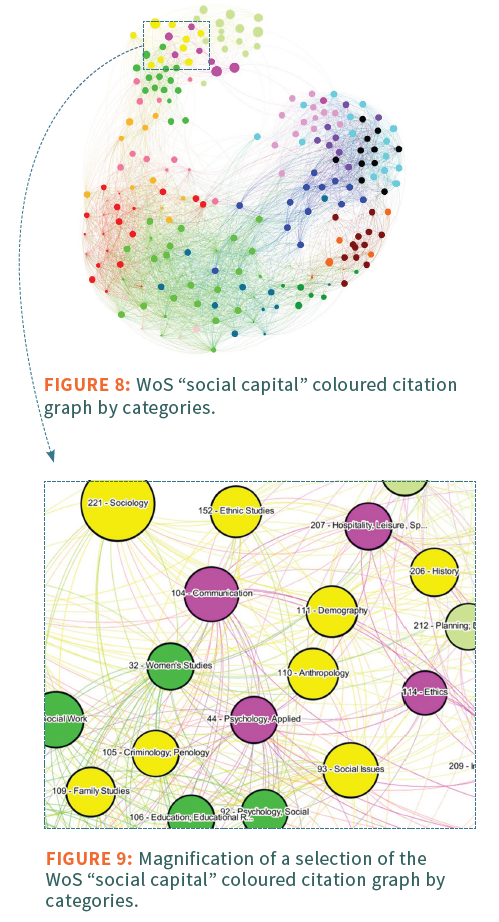
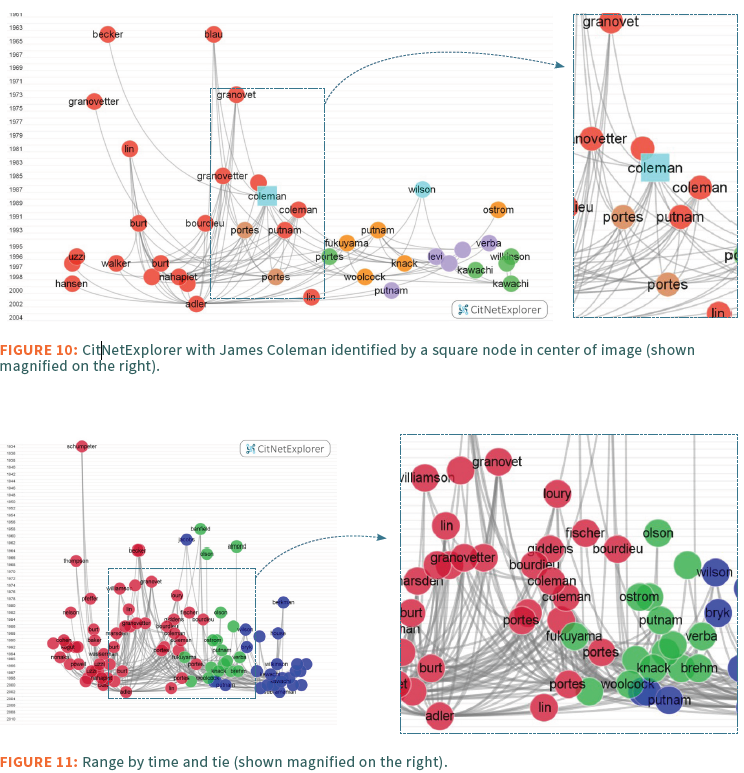







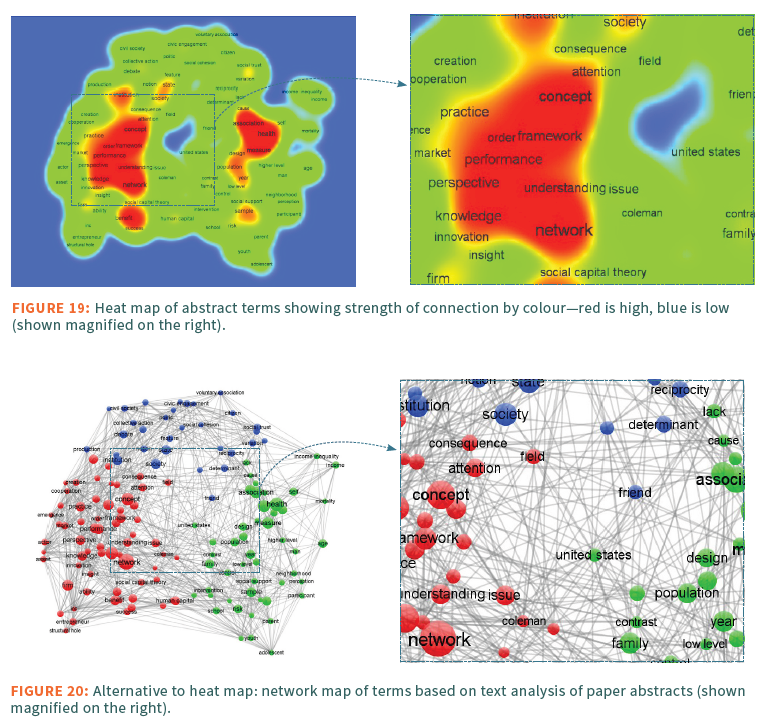
![FIGURE 21: Web of Science “social capital” abstracts with words occurring more than 3,000 times arranged alphabetically [Raw text was processed in the following way: punctuation removed, numbers removed, converted to lower case, stopwords removed using “English” stopwords from R (n = 174), words were stemmed [e.g., remove “ing,” “es,” “s”), removed definition words (“social,” "capital”), whitespace removed, and frequency matrix generated for analysis].](https://www.cardus.ca/wp-content/uploads/2024/01/Figure-21.png)
![FIGURE 22: Analysis of 1,842 social capital abstracts that include “trust” as a term with words occurring more than 600 times showing arranged alphabetically [Raw text was processed in the following way: punctuation removed, numbers removed, converted to lowercase, stopwords removed using “English” stopwords from R (n = 174), words were stemmed (e.g., remove “ing,” “es,” “s”), removed definition words (“social,” “capital,” “trust”), whitespace removed, and frequency matrix generated for analysis].](https://www.cardus.ca/wp-content/uploads/2024/01/Figure-22.png)
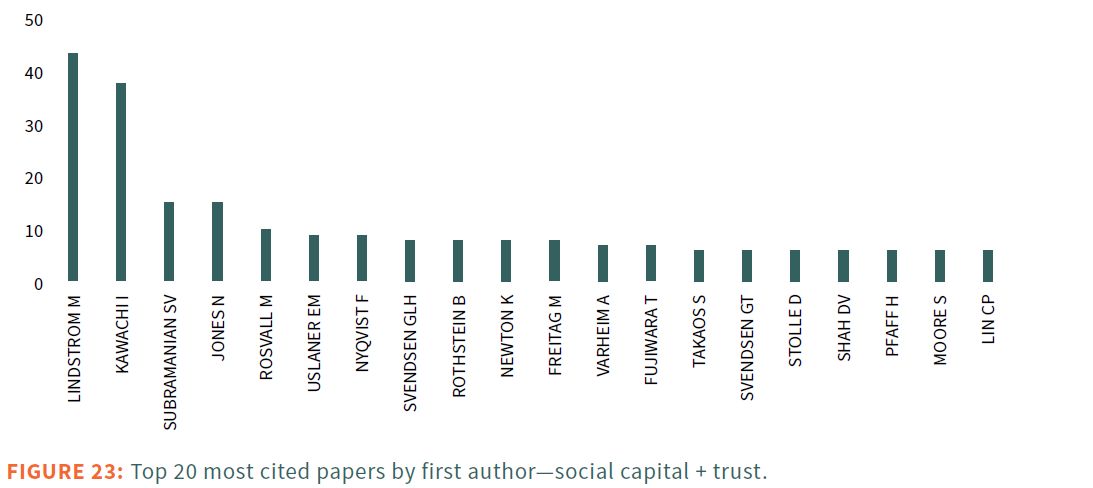
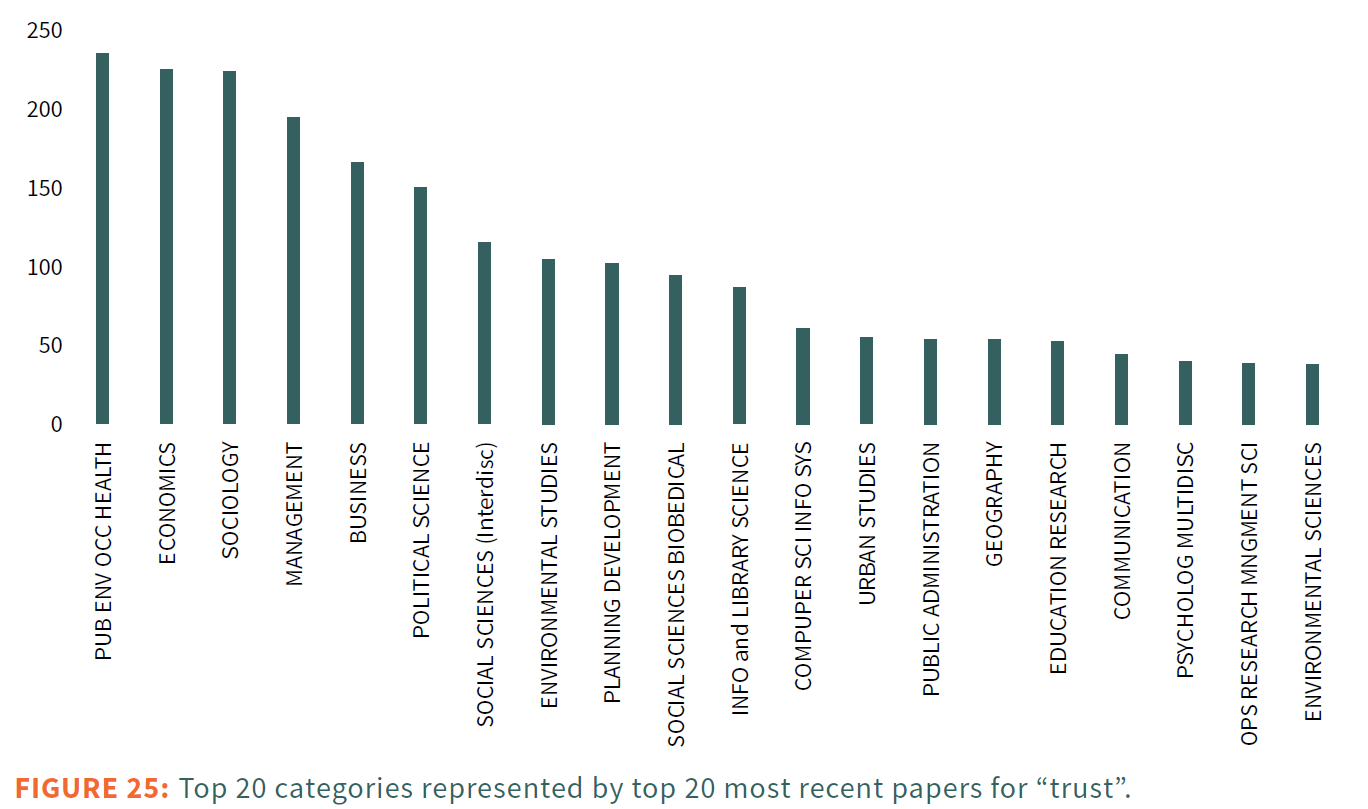
![FIGURE 26: Analysis of 243 social capital abstracts that include “measurement” as a term with words occurring more than 80 times showing arranged alphabetically [Raw text was processed in the following way: punctuation removed, numbers removed, converted to lowercase, stopwords removed using “English” stopwords from R (n = 174), words were stemmed (e.g., remove “ing,” “es,” “s”), removed definition words (“social,” “capital,” “measurement,” “measure,” “measures”), whitespace removed, and frequency matrix generated for analysis].](https://www.cardus.ca/wp-content/uploads/2024/01/Figure-26.png)
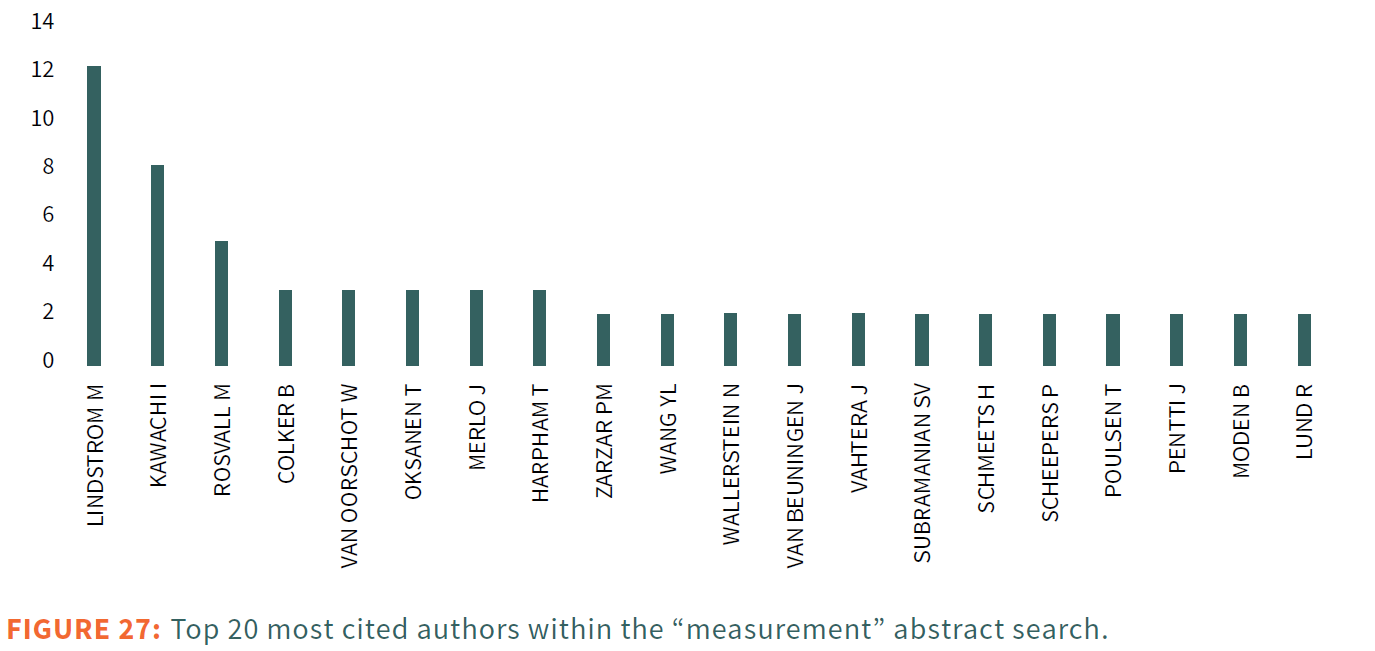
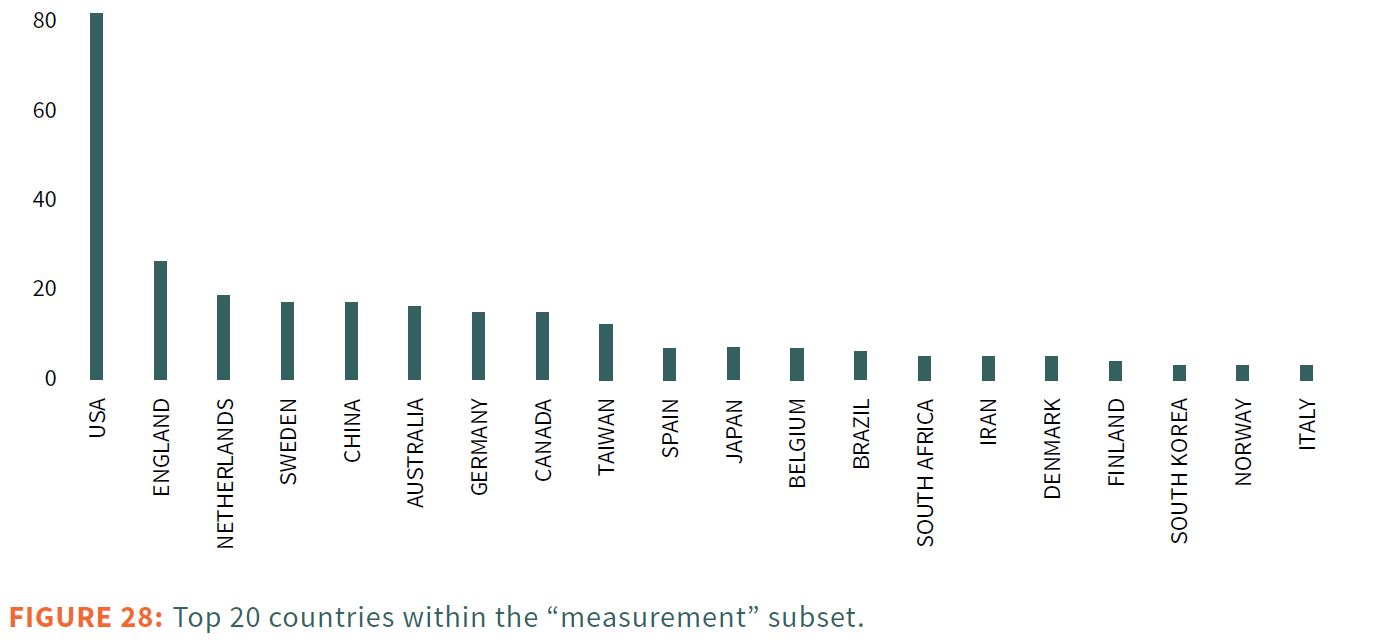
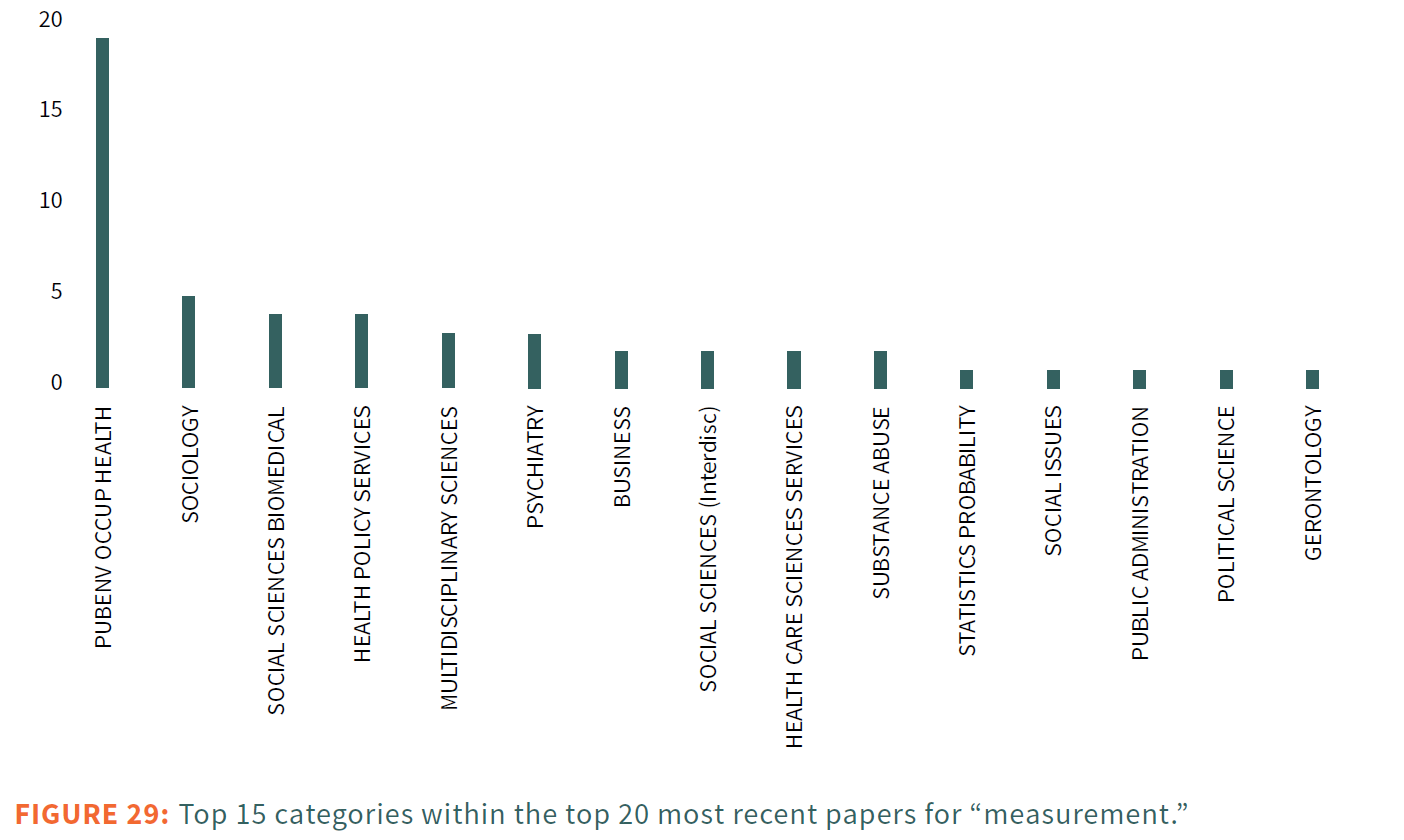
![FIGURE 30: Analysis of 187 social capital abstracts that include “spatial” as a term with words occurring more than 60 times showing arranged alphabetically. [Raw text was processed in the following way: punctuation removed, numbers removed, converted to lower case, stopwords removed using “Eenglish” stopwords from R (n = 174), words were stemmed (eg.e.g., remove “ing”,,” “es”,,” “s”), removed definition words (“social”,,” “capital”,,” “spatial”,,” “space”), whitespace removed, and frequency matrix generated for analysis].](https://www.cardus.ca/wp-content/uploads/2024/01/Figure-30.png)
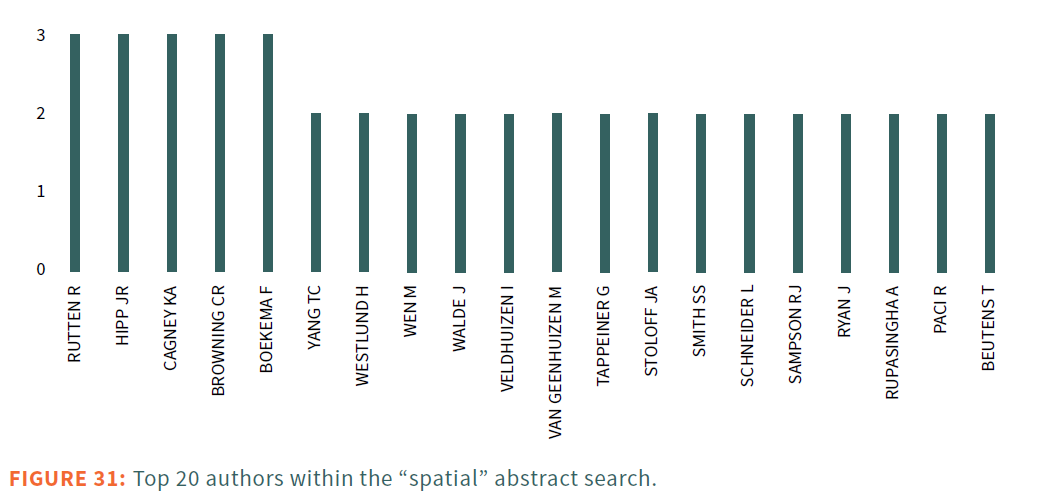

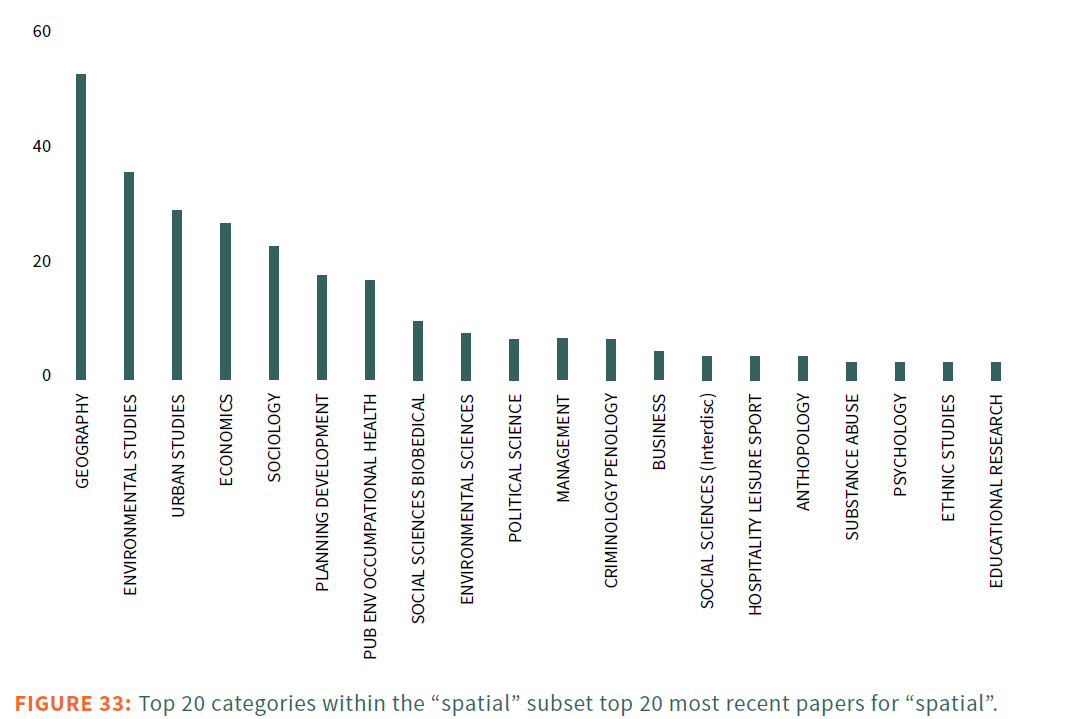
![FIGURE 34: Analysis of 93 social capital abstracts that include “isolation” as a term with words occurring more than 40 times showing arranged alphabetically [Raw text was processed in the following way: punctuation removed, numbers removed, converted to lowercase, stopwords removed using “English” stopwords from R (n = 174), words were stemmed (e.g., remove “ing,” “es,” “s”), removed definition words (“social,” “capital,” “isolation,” “isolate”), whitespace removed, and frequency matrix generated for analysis].](https://www.cardus.ca/wp-content/uploads/2024/01/Figure-34.png)
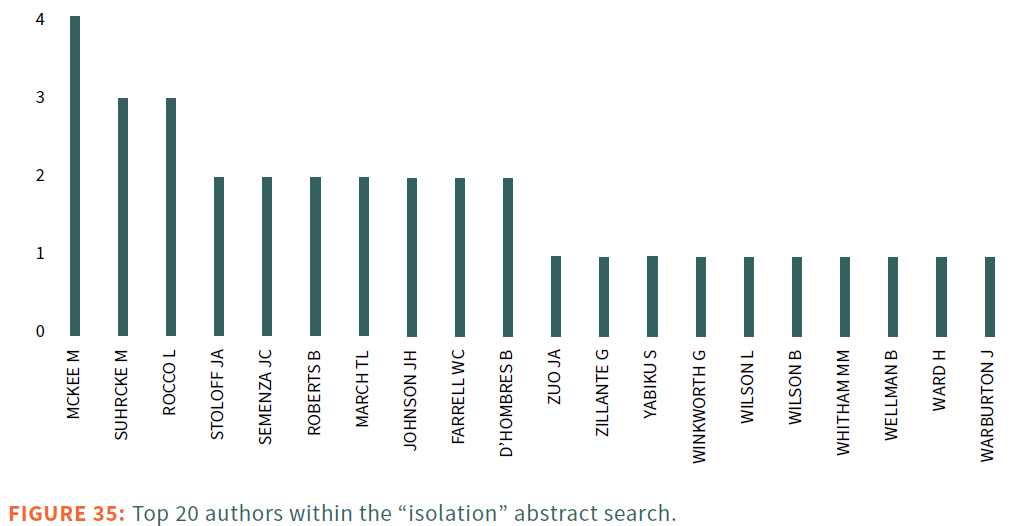
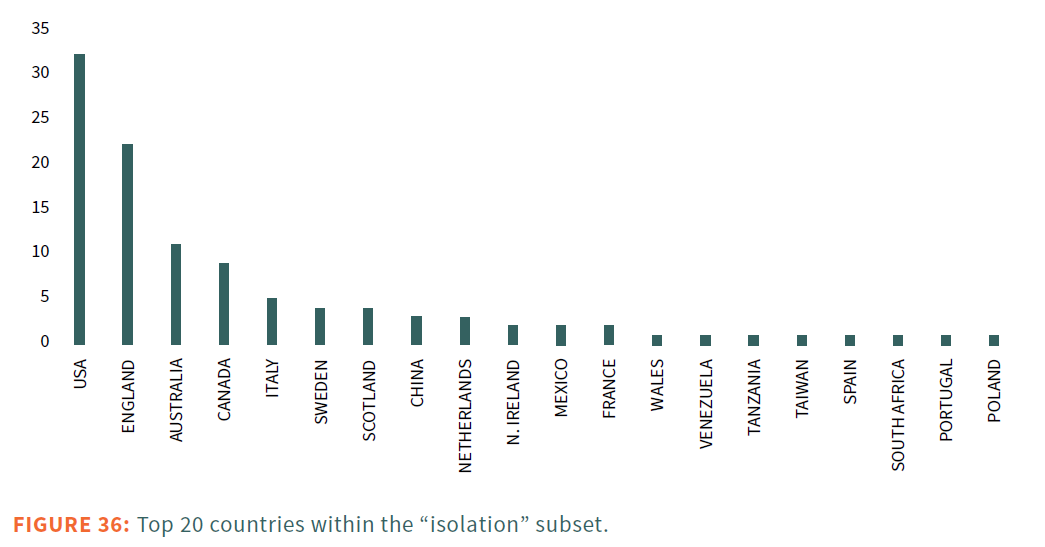
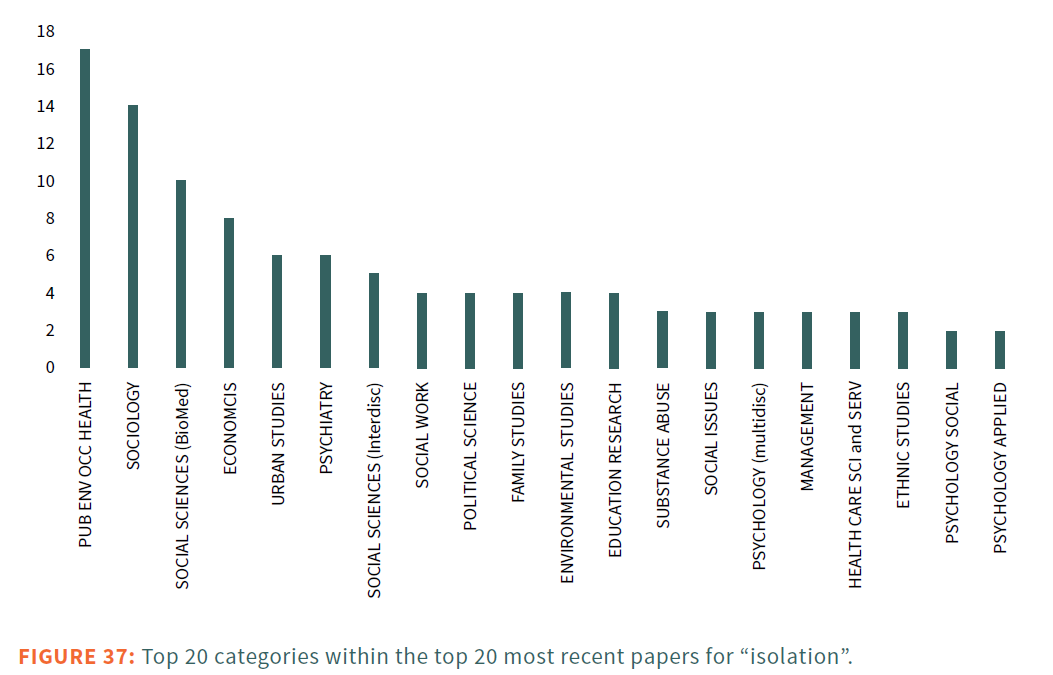
SOCIAL ISOLATION AND SOCIAL CAPITAL
Isolation is an important area of research within the social capital core data set because it represents an antithesis to social cohesion. Social capital is a collective phenomenon and social isolation therefore represents scarcity of social resources. The top citations that link social capital and isolation are health related. The health concerns include geriatric health and social isolation (Boneham and Sixsmith 2006; Warburton and McLaughlin 2005), pregnancy and depression (Raymond 2009), and psychiatric impacts (Haynie, South, and Bose 2006; Kelly 2005). Overall, the quality and relevance of the search return on this subcategory is much lower than the other systematically selected papers and reflect an eclectic mix within and outside of the health-related themes. Current scholarship revealed a similar mixed data set. The data generated by isolation as a subset of social capital needs further attention, and it may be worth pursuing a search of “social isolation” within the full WoS Core Collection and then exploring for social capital themes within that. Sources range from agriculture (Serra and Poli 2015), to heritage buildings (Gregory 2014), to disaster response (Gill 2014; Olcott and Oliver 2014), to methods (Wang t al. 2014), to economic history (Fourie and von Fintel 2014).